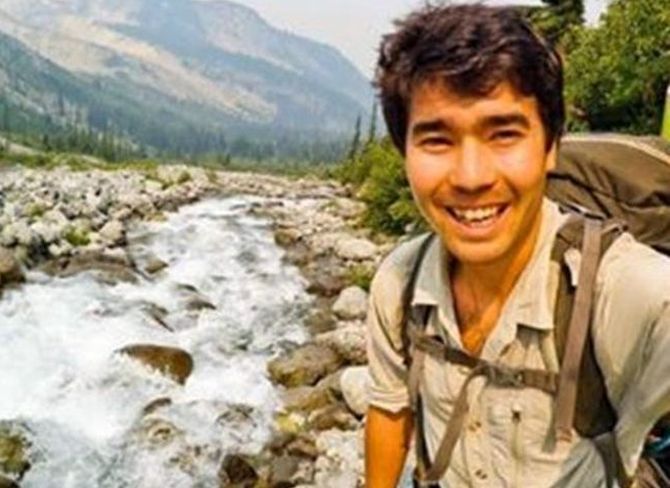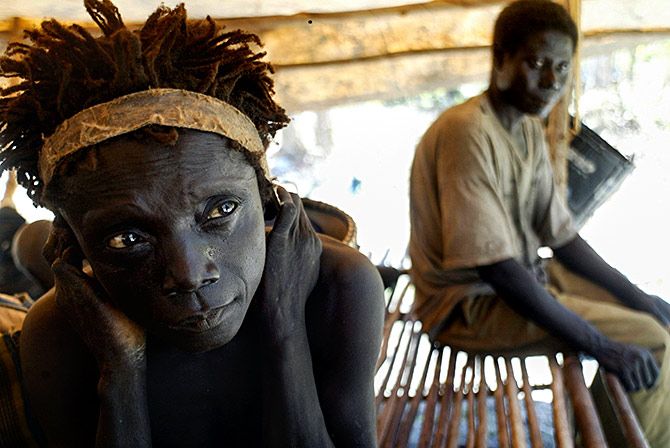 | « Back to article | Print this article |
'Today we can't confirm whether Chau is dead or not.'
'What is the guarantee that the Sentinelese killed him?'

The presumed killing of American John Allen Chau with arrows by one of the world's most isolated and uncontacted tribes, the Sentinelese, has brought the focus on the gravely endangered tribes who live in the archipelago.
The Andaman and Nicobar islands are home to five aboriginal tribes.
Denis Giles, editor of the Andaman Chronicle, who exposed the exploitation and sexual abuse of the Jarawa tribe in the Andamans, says based on two incidents it is being assumed that the Sentinelese kill people to defend their territory.
"When anthropologist T N Pandit went there in 1967, it was proven that they don't kill people. He had offered them coconuts," says Giles whose family was brought to the islands by the British.
In present day India, locals have been issued an islander card that deems them residents of the Andaman and Nicobar islands.
"Let us ask ourselves how much islanders are we? When was the last time we swam in the sea, went fishing or ventured into the jungle? We don't belong here except the fact that we live in a concrete jungle inside the island. These tribes are the real islanders," Giles tells Rediff.com's Archana Masih over the telephone from Port Blair.
As an activist for endangered tribes in the Andamans, a journalist and a local, how do you assess the fate that befell John Allen Chau?
From the beginning we locals have known that the Sentinelese are hostile to outsiders, even fishermen did not venture near the island.
Since childhood I have been hearing that if fishermen go fishing in that area, they carry metal shields to protect themselves in case an arrow is aimed towards them.
If you venture into that area, they will retaliate and chances are that you will get killed.
The Sentinelese are also referred to 'Pathan Jarawas'. They resemble the Jarawas, but are more feared than the Jarawas. They are called 'Pathan' because they are taller than the Jarawas.
There is no way to measure them, of course. The expert's estimate is that their population must be from 50 to 500. The numbers depend on the resource availability on the land.
They are a hunting and gathering community. They need an area with fishing activity, fruits, honey, wild boars and potatoes.
John Allen Chau is believed to have been killed by arrows. Were you surprised to know this?
As per his journal, there were two men with bows and arrows and a boy.
When he threw gifts they were not defensive, but from behind them, the boy pulled an arrow and shot at Chau.
The arrow struck the Bible he was carrying. He also writes that the cover of the Bible resembled a bark.
Maybe, the boy shot the arrow out of curiosity.
If the Sentinelese really wanted to kill him, the first arrows should have been (shot) by the two men.
Today we can't confirm whether Chau is dead or not. What is the guarantee that the Sentinelese killed him?
Is it almost impossible to retrieve his body?
It is not impossible. It is unethical.
Three attempts were made, but no attempts were made to land on the island on the advice of anthropologists who were part of the team.
On the last attempt two accused fishermen were also taken to identify the spot, but surprisingly, according to my very reliable sources, they could not identify the location.
That was the last expedition or investigation that was done.
After a hue and cry of activists there have been no attempts to go near the island.
Mr T N Pandit, the first anthropologist to land on the island in 1967, came back alive and said in an interview that he was surprised to know that the Sentinelese killed Chau.
It was proven at that time that they are not hostile and don't kill people. T N Pandit had offered them coconuts.
If we go through Chau's journal, he mentions that he tries to share some gifts with the Sentinelese which they gradually accepted.
Based on two incidents -- one in 2006 when two fishermen were killed and Chau's -- we come to know that the Sentinelese kill people to defend their territory.
But again in John Allen Chau's case there is no confirmation that the Sentinelese have killed him.
The only information we have is from three fishermen who say they saw Chau's body being dragged and buried. But whether he was killed by the Sentinelese is no confirmation.
In 2006, two fishermen were killed by the North Sentinelese, the news was flashed, but did anybody see them being killed?

Anthropologists have said the Sentinelese should be left alone.
The anthropologists have said any attempt to retrieve the body will result in a sort of xenophobia among the tribals. They conclude that if Chau's body is there, the Sentinelese will try to be near it because there is a kind of fear from the outsiders.
It also keeps them away from their day to day activity.
They survived the tsunami and have survived for thousands of years and are the first and rightful claimants of the land.
I am a local. All locals have been issued an islander card that deems us residents of the Andaman and Nicobar islands.
Let us ask ourselves how much islanders are we?
When was the last time we went swimming in the sea or went fishing or ventured into the jungle?
Do we even know what it feels being in a jungle?
We will realise that we hardly know anything about our island and don't belong here except the fact that we live in a concrete jungle inside the island.
These tribes are the real islanders.
Do we want the Jarawas and Sentinelese to live with the pressures of the outside world and live with diseases like diabetes and hypertension?
Is tribal tourism a big draw in Andaman and Nicobar?
When it comes to tribal tourism, only Indian tourists are really interested.
The majority of Indians, I don't understand, the moment you say there is a naked person or a naked girl, or a people who don't wear clothes, they are very curious to see them.
My experience says that even a 70-year-old man, if you tell him that there are tribals who don't wear clothes and are bare chested, this man will easily pay Rs 3,000, Rs 4000 to have a glance of that.
If you see the tourism trend in the islands, it is not the foreigners who are interested unless they are people like John Allen Chau or some journalists.
In June the Union home ministry lifted the restricted area permit and opened up access to 29 islands by tourists. You have criticised this policy.
I have tried to defend the rights of aboriginal tribes here since 2002. It was a big blunder committed by the Government of India.
It specifically mentions 29 islands removed from the Restricted Permit Area regime. Surprisingly, it includes islands inhabited by vulnerable tribal groups, including North Sentinel.
Since the beginning, all areas of aborigines inside the Andaman group of islands have been protected and there is no chance that any tourist can be given a permit to go inside these areas.
The entire Nicobar island is a tribal district, but unlike the Sentinelese, the Nicobarese are educated -- they are officers in the administration itself.
Since it is a tribal reserve there is a tribal pass which is issued by the A&N administration to enter Nicobar.
As a resident of the Andamans, do you also need a permit to visit the Nicobar group of islands?
I am born and brought up here. My mother's family belong to the penal convicts brought by the British. In spite of that, I need that pass to go to Nicobar.
When no tourist is given that pass to enter North Sentinel, why was North Sentinel, Strait Island, home to the Great Andamanese, and Little Andaman, home to the Onge tribe, removed from the RPA regime?
Does that not mean that the government is preparing for tribal tourism? Maybe in a controlled way?
At the same time, the A&N administration comes out with a circular that these are protected area and totally closed to outsiders or outside influence.
This is a big contradiction and confusion and questions the intent of the Government of India on tribal welfare.
RPA should be reinstated. The government wants to bluff the world that it is protecting its tribals.
In spite of FIRs and judicial custody against many accused charged with violating tribal rights, not a single offender has ever been convicted.
The Supreme Court had issued an order to close the road that went through the Jarawa tribal reserve after incidents of exploitation and abuse of the endangered Jarawa tribe? Has that been adhered to?
The Supreme Court in 2002 clearly indicated that two sections of the road that directly went through the Jarawa territory should be closed.
The administration did not implement this judgement and kept sending pleas that the Andaman Grand Trunk road is the lifeline of the people of Andaman and that they will try their best to control tourism in that area.
It was also suggested by the National Advisory Committee during the Congress regime that there should be an alternate sea route.
This alternate sea route existed when I was a child, but after the Andaman Trunk Road became popular, this shut down.
When the Supreme Court suggested opening this sea route, the administration came out with a plea that after the tsunami there has been a lot of disturbance in the sea and dredging activity would take some time.
But the Supreme Court insisted and after a lot of hue and cry, the jetty was expanded and this route was opened finally in 2017.
The administration followed the Supreme Court order, but did not publicise this route and tourists continue to travel by this road.
What do you think of bringing ancient tribals and their land into the mainstream looking at how tribes have dwindled because of such measures to 'civilise' them?
The point is what lies in the mainstream. What do we have to offer tribals?
Why can't we understand that the tribals of the Andaman islands have been living here for the past 60,000 odd years and have kept the forests, natural resources and themselves intact.
The interference has been by so-called civilised people like us.